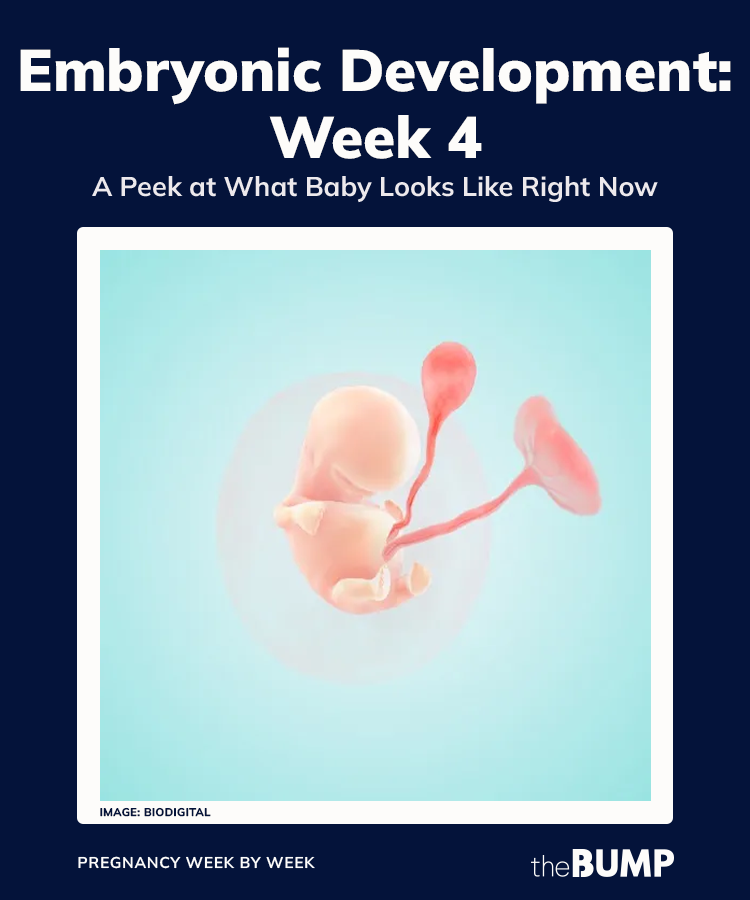- You probably don’t know you’re pregnant yet. Of course, if you’re the test-every-day type, then maybe you do! Some home pregnancy tests can detect human chorionic gonadotropin (hCG) in your urine before a missed period.
- Baby isn’t technically even an embryo quite yet; rather, they’re a blastocyst, a teeny-tiny, nearly invisible clump of cells burrowed in the uterus.
- You probably don’t have pregnancy symptoms yet, but they may kick into high gear in the next week or so as hCG rapidly increases in your body.
- If you got a positive pregnancy test, it’s time to find yourself an ob-gyn or midwife and make that all-important first appointment. You’ll have to be patient, some practices won’t schedule you to come in for another two to four weeks.
If you know you’re 4 weeks pregnant, you found out the news earlier than a lot of women do (because you took a test as soon as you missed your period, or even a few days before, instead of waiting a bit). Your first call at week 4 of pregnancy should be to your doctor to schedule your first prenatal visit, where they’ll confirm your pregnancy with a urine or blood test. For updates on what’s happening with you and baby throughout your pregnancy, sign up for The Bump pregnancy week-by-week newsletter emails.
During week four of pregnancy, the ball of cells (blastocyst) is splitting into the embryo (your future child) and placenta. Within the blastocyst, there’s an inner group of cells that’ll become the embryo; this cluster will continue to develop throughout your pregnancy. The outer layer of the blastocyst will create part of the placenta, which will eventually help deliver nutrients from you to baby during your pregnancy.
And that’s not all that’s happening at this super-early stage: Baby's neural tube, the building block of the spine, brain and backbone, has already formed. The amniotic sac and fluid are forming into protective cushioning for baby too.
How big is baby at 4 weeks?
At 4 weeks pregnant, baby is smaller than a poppy seed—practically microscopic. Again, baby is now known as a blastocyst, a teeny, tiny ball of rapidly dividing cells. It’s a crucial time as the uterus (aka baby’s home) becomes ready for their nine+-month inhabitant. Buckle up—there will be major development and growth that’ll happen over the next six weeks.
Is there a heartbeat at 4 weeks pregnant?
At 4 weeks pregnant, your little blastocyst doesn’t have a heartbeat quite yet. A blood vessel has begun to form, which will become the heart and circulatory system in the next several weeks. The heart will continue to develop until the 10th week but will begin to beat in the 5th or 6th week.
4 week ultrasound
A 4 weeks pregnant ultrasound would essentially look like a tiny dot, called the gestational sac. Chances are, though, you won’t have an ultrasound at 4 weeks. When you call the OB to tell them you’re 4 weeks pregnant, they might share congratulations and then have you make your first prenatal appointment for about a month from now.
We know it seems like an eternity to wait. But if you have a clean bill of health and no risk of pregnancy complications, there simply isn’t a need to be seen by a doctor just yet. There will be much more for the OB to see (including a heartbeat!) around week 8 or 9. In the meantime, eat well, drink lots of water, avoid unhealthy habits like drinking and smoking and try to relax.
The same pregnancy hormones that gave you that positive pregnancy test can also cause some of the more typical 4-week pregnancy symptoms. These hormone levels increase pretty quickly, so while it’s normal to be 4 weeks pregnant with no symptoms, brace yourself: nausea and vomiting may be in your near future. Here’s a bit of what to expect at 4 weeks pregnant:
Bloating
You may be a little puffed up thanks to the pregnancy hormone progesterone. Break out the comfy pants!
Mild cramping
At 4 weeks pregnant, cramping might worry you, but it actually may be a sign that baby has properly implanted in the lining of your uterus. However, any severe cramping or pain at 4 weeks pregnant is something you should definitely tell your doctor about right away, since they’ll want to examine you to rule out any problems.
Spotting
Light bleeding can also occur during week 4 as a result of implantation. Don't worry—this is totally normal too. But the same advice goes: If it’s a lot of blood, like a period or heavier, lasts for more than a couple days, or if you’re concerned in any way, see the doctor.
Mood swings
It’s not your imagination. Your mood is going haywire mostly because of your fluctuating hormones. (But maybe also because of stress and because your mind is racing.) Pregnancy mood swings are most drastic during the first 12 weeks. After that, the hormones will level out a bit, making you less likely to cry at every life insurance commercial you see.
Morning sickness
Experts say that about 50 to 90 percent of pregnant women get some form of morning sickness (aka nausea and sometimes vomiting too). So even if you haven’t had an upset stomach yet, you probably will at some point. Morning sickness is usually at its worst around nine weeks and then slowly gets better, typically disappearing completely in the second trimester.
Fatigue
One of the most common 4 weeks pregnant symptoms is total exhaustion, as your body is working hard to grow that teeny ball of cells into an embryo.
Sore breasts
Yowch! Your breasts are swollen and tender because of those surging hormones telling your body, “There’s a baby coming. Better start prepping those milk ducts!”
Is it normal to be really tired at 4 weeks pregnant?
It’s totally normal to be completely worn out and feel like you need a nap after tying your shoes at 4 weeks pregnant. Fatigue is one of the main symptoms of early pregnancy, and it’s no wonder—you’re growing a brand new person inside your body! Get in the habit of going to bed early and napping when you can.
A 4 weeks pregnant belly might be a little bloated, but you almost certainly don’t look pregnant yet. Still, you need to start acting like a mom-to-be—and that means giving TLC to yourself and your tiny baby-to-be.
Baby is already undergoing important development at week 4 of pregnancy, so start taking a prenatal vitamin if you’re not already. Look for one with at least 400 micrograms of folic acid and remember to take it daily. We know you’ve got a lot on your mind, but since folic acid is proven to help prevent birth defects, this is super-important!
As your skinny jeans get more difficult to button, don’t shy away from looser clothing styles. Think: stretchy pants, leggings, drapey shirts and waterfall cardigans. There are a ton of loose-fitting clothing options that will help you look stylish and stay comfy.
Your mind may be spinning. What if I'm a high-risk pregnancy? What if I have a lot of nausea and vomiting and can’t drink or eat? What if I'm bleeding? What if this pregnancy doesn't carry to term? Welcome to pregnancy which is just the beginning of ‘what if’s’ as a parent… Be kind to yourself, be in the present and recognize that at this moment in time, you have a positive pregnancy test—get ready for an adventure!
Below, words of wisdom to help you take on this early stage of pregnancy.
Get around a queasy tummy
Around 4 weeks pregnant, you may be just starting to feel nauseous and experience aversions to certain foods, smells and textures. If that’s the case, start eating a snack first thing in the morning and consider asking your partner to prepare food for you so you don’t feel sick before it’s even time to eat.
Switch when you take your vitamin
Continuing to take your prenatal is important, particularly if you’re having trouble consistently eating well because of nausea. Unfortunately, some people find that taking their prenatal vitamin in the morning or during the day can send an already queasy tummy over the edge. If your prenatal is making your morning sickness (or all day sickness) worse, try taking it with a small snack before bed, or split your dose so you take half in the morning and half at night.
Get your vitamin D
Both you and baby need vitamin D to support calcium absorption and help build (or maintain!) healthy teeth and bones. Try getting at least 15 minutes of sun everyday to start, then look to your diet. Fortified milk products, eggs, sardines and salmon are all excellent sources of vitamin D. Fortified breakfast cereal can also be a good source (especially when you eat it with milk).
Sneak healthy foods into yummy snacks
Still having trouble stomaching the wholesome foods you need for a healthy pregnancy and baby? Hide ’em! Try sneaking dark, leafy greens into fruit smoothie with blueberries, mango and banana. Ground or finely chopped meat can be hidden in saucy dishes. Tofu can be blended into a multitude of recipes. Get creative with incorporating healthy ingredients in sneaky ways, and you just might be able to get the nutrients you need without even noticing.
Frequently Asked Questions
Is cramping normal at 4 weeks pregnant?
Rest assured that cramping can be normal. During this time, the embryo continues to implant in your uterus and buries itself deep into your endometrium, which is the layer of tissue that lines the uterus. As a result, you might feel slight cramping and may even experience some spotting. This can sometimes be confused with a period, since it usually happens around the time in your cycle.
When do mood swings start in early pregnancy?
Mood swings in pregnancy are caused by the rise of the hormones estrogen and progesterone. These increases can impact mood-regulating chemicals in your brain like dopamine and serotonin. Couple that with the stress and anxiety that can come with pregnancy, and you’ve got yourself a recipe for mood swings. In fact, early mood swings may be one of the first signs you’ll notice in your journey. But they don’t end in the first trimester; they can occur at any stage of pregnancy.
How long do your breasts stay sore in early pregnancy?
Not everyone has sore breasts in pregnancy in pregnancy, but many women do. Soreness and sensitivity are likely caused by increased blood flow to your chest—which is a result of surging hormones. Sore breasts can start in early pregnancy and typically last until the end of the first trimester. Of course, some people with sensitive breasts may feel changes in the second and third trimesters too. As with most pregnancy symptoms and side-effects, the experience varies from woman to woman and pregnancy to pregnancy.
When will I start noticing physical changes during my pregnancy?
Every pregnancy is different and physical changes will vary. Some moms-to-be don’t notice physical changes until the second trimester, when the uterus starts to push out of the pelvis and baby gets larger. But if this is a subsequent pregnancy, you may start to show earlier.
What's the difference between an OB and a midwife?
An ob-gyn or OB is an obstetrician, a medical doctor who has special training and education in women’s health. A midwife (or certified nurse midwife), on the other hand, is a trained healthcare professional who cares for a mom-to-be throughout pregnancy as well as during labor and delivery. Both experts can deliver babies during uncomplicated vaginal births, but a midwife is not a medical doctor. As a result, choosing an OB is often ideal for those with high-risk pregnancies, including women who are 35 and older, or have existing conditions, like diabetes or hypertension.
Shock—total shock set in when I saw that positive test. I turned to my husband and said "how did this happen?" He laughed. Of course I knew how it happened, I just wasn't prepared for it to happen so fast!
Please note: The Bump and the materials and information it contains are not intended to, and do not constitute, medical or other health advice or diagnosis and should not be used as such. You should always consult with a qualified physician or health professional about your specific circumstances.
Matthew Carroll, MD, is an ob-gyn and assistant professor of obstetrics and gynecology at Baylor College of Medicine. He earned his medical degree from the Mount Sinai School of Medicine in New York.
Christine Greves, MD, is an ob-gyn at the Winnie Palmer Hospital for Women and Babies in Orlando, Florida. She earned her medical degree from the University Of South Florida College Of Medicine.
American College of Obstetricians and Gynecologists (ACOG), About ACOG
American College of Obstetricians and Gynecologists (ACOG), How Your Fetus Grows During Pregnancy (ACOG), January 2024
American College of Obstetricians and Gynecologists (ACOG), Ultrasound Exams, October 2021
American Pregnancy Association, 4 Weeks Pregnant
American Pregnancy Association, Mood Swings During Pregnancy
American Pregnancy Association, Your First Prenatal Visit
Centers for Disease Control and Prevention, Planning for Pregnancy, February 2023
Centers for Disease Control and Prevention, Folic Acid: The Best Tool to Prevent Neural Tube Defects, September 2022
Cleveland Clinic, Blastocyst, April 2022
Cleveland Clinic, Am I Pregnant?, July 2022
Cleveland Clinic, Fetal Development, March 2023
Cleveland Clinic, Food Aversion, May 2022
Cleveland Clinic, Morning Sickness, April 2023
Cleveland Clinic, Morning Sickness? 12 Remedies That Really Work March 2022
Cleveland Clinic, Pregnancy Tests, November 2022
Environ Health Perspect, Benefits of Sunlight: A Bright Spot for Human Health, April 2008
March of Dimes, Bleeding and Spotting From Vagina During Pregnancy, April 2020
Mayo Clinic, Eating Twice as Well During Pregnancy, May 2022
Mayo Clinic, Fetal Development: First Trimester, June 2022
Mayo Clinic, Symptoms of Pregnancy: What Happens First, December 2021
Mayo Clinic, Pregnancy Week by Week, June 2022
Maternal and Child Health Journal, Maternal Influences on Nausea and Vomiting in Early Pregnancy, January 2011
National Institute of Child Health and Development, What Happens During Prenatal Visits?, January 2017
National Institutes for Health, Vitamin D Fact Sheet for Health Professionals, September 2023
Nemours Kids’ Health, Week 4 StatPearls, Embryology, Neural Tube, January 2023
Ultrasonography, Role of Ultrasound in the Evaluation of First-trimester Pregnancies in the Acute Setting, April 2020
Learn how we ensure the accuracy of our content through our editorial and medical review process.
Navigate forward to interact with the calendar and select a date. Press the question mark key to get the keyboard shortcuts for changing dates.















































